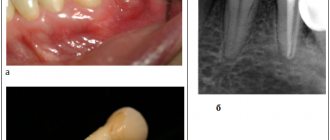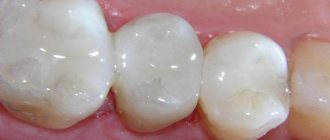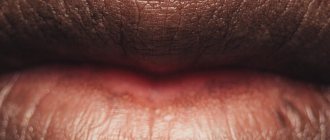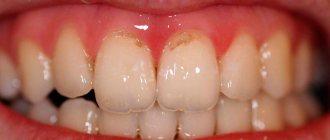Defects appear from tobacco smoke as a result of sedimentation of resins, from high levels of fluoride in the water that the patient constantly drinks. The situation is negatively affected by insufficient hygiene, as a result of which caries develops. Irregular cleaning of the chewing organs leads to the accumulation of soft and hard brown deposits. Such defects cannot be dealt with without the participation of a dentist. Contact your doctor in a timely manner to avoid complications.
Reasons for color change
Have you noticed that the filling on your tooth has darkened? Several factors could have contributed to the color change.
- Consumption of coloring products. A newly placed filling can become darkened by strong tea, black coffee, chocolate, red wine, grapes, and concentrated fruit juices. The composite can also become colored when consuming carrots, beets, blueberries, cherries, and carbonated drinks with dyes.
- Smoking. Tobacco smoke causes resins, plant alkaloids, and organic acids to settle on restored teeth, causing them to acquire a yellowish or brown tint.
- High levels of fluoride in water and food. Drinking low-quality water and foods high in mineral content can cause multiple stains on your teeth.
- Insufficient oral hygiene. If you don't clean your teeth well, stains will remain on them and bacterial plaque will accumulate. This can lead to secondary caries.
What to do if the tooth has darkened
You just need to come to the clinic for a consultation. We will remove the prosthesis and find out the cause of the strange sensations. If the crown has already been removed and a darkened tooth is visible, we will consider options for saving it. First you need to determine the condition of the root and undergo a course of treatment. In the case when it is already destroyed, removal of the remains will be required, followed by implantation.
Is there a healthy root? Then you can install new crowns on your teeth quickly using Cerec technology
.
New technology eliminates errors. This is an opportunity to make ideal dentures and quickly cover a tooth with a crown. Steps:
- The scanner determines the characteristics of the damage; adjacent and opposite units and closed rows are scanned.
- The program combines information and creates a 3D model of inlays and crowns, taking into account anatomical features. The computer calculates the dimensions of the prostheses and the nuances of their shape.
- Even before the process begins, the patient can see the result. We select the shade - each change is agreed with the patient.
- A special machine makes an inlay and a crown from a blank.
- During fitting, it is rare, but the need for correction arises. In most cases, these are nuances of the shade of the crown. But a new copy according to the template is made within 15 minutes
. - The crown or inlay fits tightly to the remaining parts of the tooth, preventing pathogenic microflora from entering the tissue.
The process takes only 1.5 hours and allows you to save a darkening tooth. This technology is the best that has been created in dental practice. Allows you to quickly and accurately produce single versions of crowns for teeth or bridges from metal-free materials - ceramics and zirconium dioxide. We will discuss the nuances of your particular case during your visit; the cost of installing a crown on a tooth starts from 27,900 rubles. There are promotions and special offers. Keep your teeth healthy and your body will thank you.
Types of darkening of restorations
Most often, fillings on teeth darken evenly. Fresh fillings may become stained in the first hours after placement if you consume coloring products. Old restorations are also subject to uniform discoloration:
- due to the effects of low and high temperatures,
- narrowing or expansion of the filling.
Less commonly, composite restorations darken around the perimeter. This occurs due to the fact that the filling material has not completely filled the carious cavity. Pathogenic microorganisms and food particles penetrate into a small crack, which leads to darkening and destruction of the filling.
Errors during the preparation stages and secondary caries
When a tooth under a filling turns black and hurts, this may be the result of poor-quality endodontic treatment. Go to another clinic and be examined using a microscope. This will make it possible to recognize even microscopic errors in previous therapy. From this, secondary caries often develops. It is provoked by shrinkage of cement that is not placed tightly. At the same time, the size of the lining decreases, which creates cavities between the material and the tissues of the masticatory organ. Bacteria thrive in such holes.
Removing an old filling requires the dentist to thoroughly clean the cavity. However, it happens that blood, organic remains, and pus remain inside the unit. When destroyed, they cause a defect in the chewing organ in the form of brown spots. Leaky application of cement or incomplete removal of pathogenic pulp also leads to problems. Common mistakes made by doctors:
- The dentist may not completely dry the tooth cavity before placing composite cement.
- Laying the material in a thick layer at a time, instead of applying it in small portions.
- Careless polymerization.
- Incomplete cleaning of pathological dentin.
After such mistakes, caries forms again. Patients complain of increased sensitivity of crowns, changes in their shade, mobility of the embedded glue, and bad breath. In this case, therapy is needed. First, the defective material is removed, then the cavity is cleaned, then treated with an antiseptic. Finally, a new composite is installed and polymerized.
Symptoms
Without a nerve, pain sensations may indeed be absent for a long time, even with significant pathologies, but since everything in the human body is closely interconnected, nearby nerves will still begin to react to the disease, sending pain signals to the brain.
They can manifest themselves in different ways:
- pain when pressing or chewing;
- swelling of the adjacent gingival tissue;
- the feeling of a “grown” tooth, it seems as if it protrudes higher than the rest of the dental arch;
- aching pain under the crown or filling, which intensifies at night;
- complication in the form of swelling on the face or under the mandibular bone;
- painful enlargement of the cervical lymph nodes.
These symptoms can develop rapidly, or they can appear gradually, progressing more and more.
Treatment after diagnosis
Once the diagnosis is made, treatment begins. It depends on how much caries has developed again. Secondary caries can occur on the chewing surface, and if the lesion is small, the entire filling may not be removed. It is enough to clean only the affected area and drill out the filling a little, then seal the cleaned area with the same material.
If the entire tooth is destroyed and caries penetrates deep into the roots, the filling will have to be completely removed. Actually, the treatment continues according to the usual traditional scheme. First, the doctor cleans out the damaged tooth tissue. If the caries has reached the nerves, they will also have to be removed (here you will have to be patient, otherwise neither the patient nor the tooth may be able to withstand the third attempt to cure the tooth).
After this most painful procedure, you need to treat the drilled cavity with an antiseptic to make it sterile for sure. After this, fill the tooth and polish the surface of the filling so that frequent friction due to the uneven surface will deteriorate it and not break prematurely.
Sometimes, if the caries under the filling is deep and has reached the roots, sometimes the treatment is delayed for several visits to the doctor, but usually no more than two. Those who have a tendency to develop caries should be very careful about preventive measures and dental and oral hygiene.
Methods for diagnosing and treating caries under fillings
It is quite difficult to determine the presence of secondary caries in the initial stages, due to the absence of symptomatic and visual manifestations. The disease is diagnosed during a follow-up appointment using diagnostic equipment (hardware diagnostics).
Diagnostics includes two stages:
- Anamnesis and initial examination of the causative tooth in order to detect visible structural changes in hard tissues;
- Hardware diagnostics (physiography) is aimed at detecting hidden changes in the structure of dental tissues.
If a pathology is detected, treatment is prescribed taking into account the individual characteristics of the patient.
Which tooth is called dead
This concept appears more in the speech of ordinary people rather than specialists. Dentists call such an incisor, canine, molar or premolar pulpless. The pulp is a collection of nerve endings and blood vessels that carry nutrients that maintain the normal condition of bone tissue.
Pulp loss occurs in three ways:
- Planned during treatment. This is necessary if a pathological process occurs inside the pulp, the only solution to which is to remove the nerve. Using local anesthesia, the dentist opens the pulp cavity, removes the soft contents and fills it with filling material, after which the tooth is sealed again.
- Before installing a crown. In this case, depulpation is sometimes carried out even in the absence of direct indications. This is done to eliminate the risk of future crown removal for root canal treatment.
- The nerve and blood vessels decomposed after prolonged inflammation that was not treated. In such cases, a person periodically takes painkillers so that the tooth stops hurting, and after a while, when the nerve is already dead, the pills are no longer needed, because the pain stops.
You should not think that removing the pulp is a guarantee that nothing in this tooth will ever hurt again. The absence of a nerve and the supply of nutrients gradually lead to a deterioration in the condition of the dentin; it becomes not as dense and strong as it was before. The enamel does not receive the necessary minerals, which are normally transferred from the blood, which affects its condition. All this makes the dead element of the dentition more vulnerable to various diseases.
Why does a dead tooth hurt?
Painful sensations in the area of a dead tooth lead the patient to bewilderment. It would seem that it can hurt if the nerve is non-functional or removed.
Important! After the nerve is removed, the tooth gradually becomes more brittle, crumbles, darkens, and eventually collapses. Proper care and careful hygiene will help delay complete destruction, but it cannot be avoided.
The process of irradiation—the spread of pain beyond the affected area—is to blame. That is, pain is provoked by a disease or pathological process that affects bone tissue, gums or a neighboring tooth.
Infection due to wear of the filling
After the nerve is removed, the dental canals are sealed to prevent infection from entering the root area.
But sooner or later the filling wears out, cracks form in it, and tiny particles break off during eating.
The service life of a filling depends not only on the qualifications of the doctor installing it, but also on the material from which the filling is made. For example, free dental offices put in cheap plastic fillings that do not last longer than one year.
Regular preventive visits to the dentist and timely renewal of worn-out fillings will help avoid the development of an infectious process.
Important! Pain caused by an infection under the filling usually intensifies when biting into hard food or eating hot, cold or sweet foods.
Repeated carious process
Filling curved dental canals affected by caries is not as simple a procedure as it seems, and inexperienced dentists sometimes do a poor job of this task.
Before filling the voids with a filling substance, the doctor removes carious areas from both soft and hard tissues, and it is important to remove them entirely . Only in this case will the canal space be sealed tightly enough so that there are no favorable conditions left for the development of relapse.
Important! Also, secondary caries develops under a filling that was installed on a poorly prepared tooth surface . Within a few months, such a filling will begin to crumble and crack, giving bacteria access to the tooth tissue.
Pulpitis
This is a consequence of advanced caries; it is diagnosed when bacteria have reached the dental pulp (tissue containing nerve endings, blood and lymphatic vessels).
Photo 1. On the left - simple caries, the lesion is only on the enamel, on the right - pulpitis, bacteria reach the pulp, possible inflammation of the nerve.
Pulpitis is characterized by pain that spreads to the entire jaw, including the tissues of the tooth, which has not been innervated for a long time. When pain appears, it can be difficult for the patient to determine which tooth is the source of inflammation.
It is noteworthy that pain during pulpitis appears for no apparent reason and intensifies at night.
Periodontitis
The inflammatory process that affects the tooth root and nearby soft tissues is called periodontitis. The infection penetrates the root canal and starts a process that provokes severe pain (in particular, when closing the jaws).
Periodontitis also causes an increase in body temperature and swelling in the area of the tooth root. In advanced cases, an impressive area of the gum, cheek, and even lip swells.
Important! Doctors know cases of asymptomatic, at first glance, periodontitis. It can be recognized by the gum tissues that have changed color: they darken, acquire a bluish tint, as if they are filled with blood.
Swelling and severe pain are associated with the accumulation of purulent masses around the root of the tooth. Delay in treatment for this disease risks the spread of infection throughout the body.
A filling fell out - how will they treat it?
It all depends on the specific case. Before treatment, the tooth cavity is cleaned with a drill machine to remove any remaining filling material.
- Part of the filling has fallen out - the remaining part is removed and re-sealed.
- A filling with a piece of tooth falls out - they make a filling or install an inlay (more reliable than a regular cement filling). In case of radical destruction of the crown, pins are installed, and then (for greater tooth strength) an artificial crown.
- A filling with a pin has fallen out - if the root is intact, the pins are re-installed into the tooth and covered with a crown. If, after a filling falls out, a tooth breaks (the entire crown part falls off) and the roots are damaged, it is necessary to remove the remains of the tooth and install a prosthesis (bridge or implant).
To minimize the risk of a filling falling out, contact the First Family Clinic of St. Petersburg. Experienced dentists provide high-quality treatment for caries and reconstruct teeth after the filling has been destroyed.










